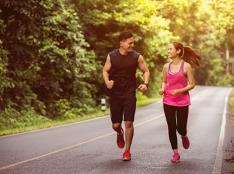The impact forces on the joints of the feet, ankles and knees are hard on runners to begin with and to take away the only thing that absorbs some of this impact with the expectation that you won't get hurt and you might even get faster is comical.
If you've actually tried this, then you know that running 3 miles with a pair of minimalist shoes on pavement feels like a 20-mile run in a pair of cushioned trainers. Every bone, tendon and ligament in your body will agree with me. And so might your physical therapist, who will likely treat you with an overuse injury following a few of those "easy" 3-mile jaunts. I've worked for many years as a physical therapist and have treated my fair share of Marines who bought into the hype of barefoot running at the height of its popularity.
Yes, the Kenyans and the Tarahumaras are fast—and fast over long distances. But it also must be said that they live and train at altitudes over 8,000 feet above sea level, and their feet have developed from birth in a way that occupants of industrialized societies can't recreate. They've also been running since the age of 2—mostly for purposes of transportation. You see, they can't afford cars either. Something tells me this is why these guys and gals are so damn fast. Running is part of their culture, part of their livelihood, and that has nothing to do with footwear.
More: 10 Quick Fixes to Save Your Knees
The New Wave
I'm not just hating on barefoot shoes, either. The pendulum has recently swung in the opposite direction. The new kid on the block is maximal cushioning—running shoes that look like your foot is being consumed by a giant marshmallow.
Maybe this new trend has something to do with the previous minimalist one. Maybe all those people who bought into barefoot running decided to cash out, and the alternative was to run in the opposite direction. Whatever it is, there will be suckers who will run to the store and buy an ultra-cushioned pair with the hope that this "new" shoe will be everything they need. It'll make them faster in less time and provide a lifetime of injury-free running.
More: 5 Women's Running Fashion Trends
If you believe that, I've got something I'd like to sell you too. There's a reason trends like these don't last. In endurance sports, there are no quick fixes. Training to get faster is hard as hell for a reason. If it were easy, you wouldn't get satisfaction from your achievements. It's hard to wake up in the morning and head out for a run when you're dead tired. It's hard to make yourself go outside and run in the rain, in the cold or after a long, ruthless day at work. It takes sacrifice, willingness to suffer and plenty of determination. You can't get that in any store in any country, and that's what makes running so special.
Finding the right shoe comes from years of trial and effort—learning about your body and how it responds to change. Eventually, you'll figure out exactly what works for you. There aren't any gimmicks that can help you achieve your goals quicker without consequences (possible injury, expense, etc.). There are no shortcuts to success. You have to earn it—and that means training hard, being smart, eating a healthy diet, and finding a shoe that fits your needs—not those of an ancient tribe that chugs chia seed juice for breakfast.
If you want to give the barefoot thing a try, or even put a pair of those marshmallows on your feet—by all means go for it. You aren't hurting me. Just know that to get faster you're going to have to put in the miles, one foot in front of the other, just like the rest of us.
More: Strava for Runners: A Worthy Training Partner
 Sign up for your next race.
Sign up for your next race.
- 3
- of
- 3
About the Author
Get ACTIVE on the Go


Couch to 5K®
The best way to get new runners off the couch and across the finish line of their first 5K.
Available for iOS | Android







Discuss This Article